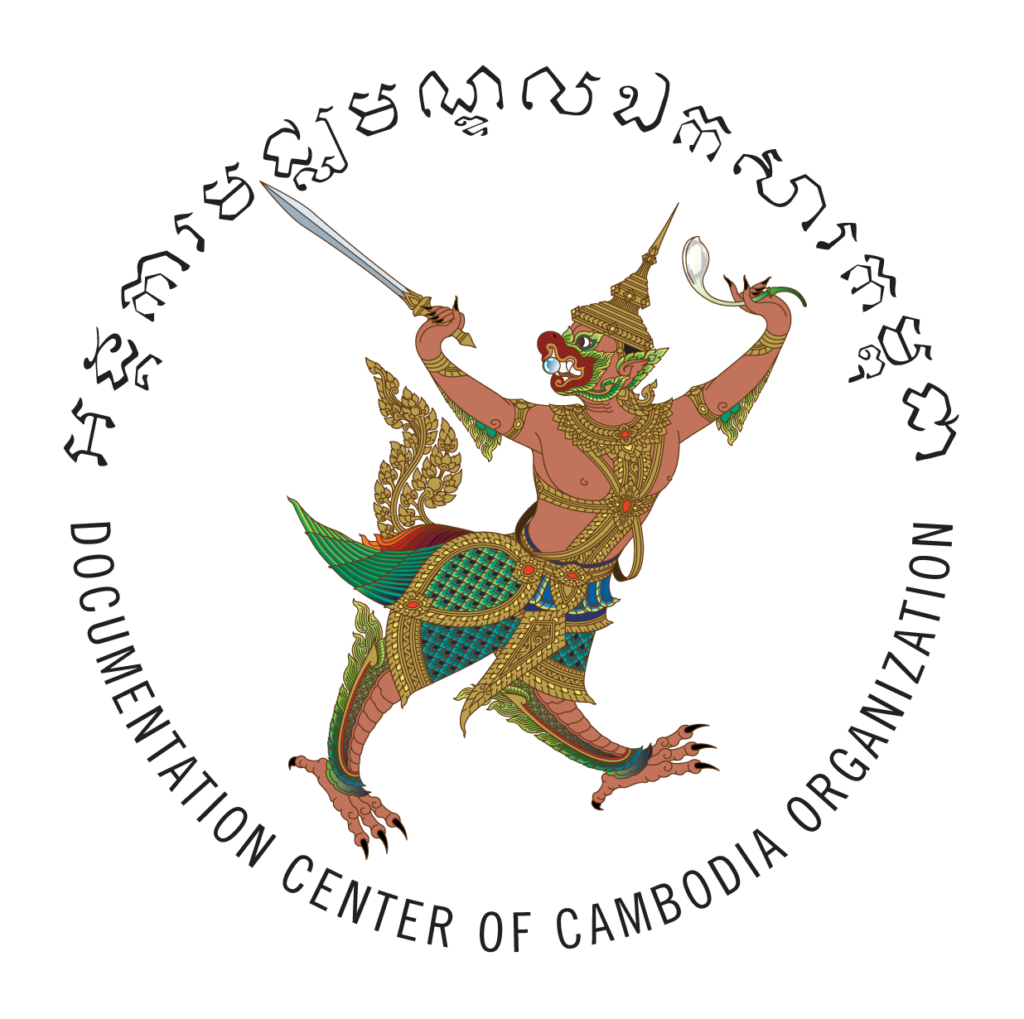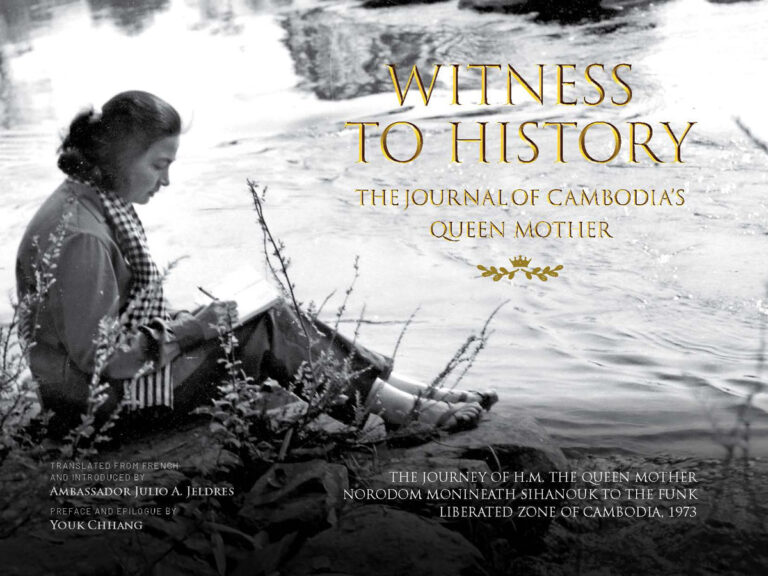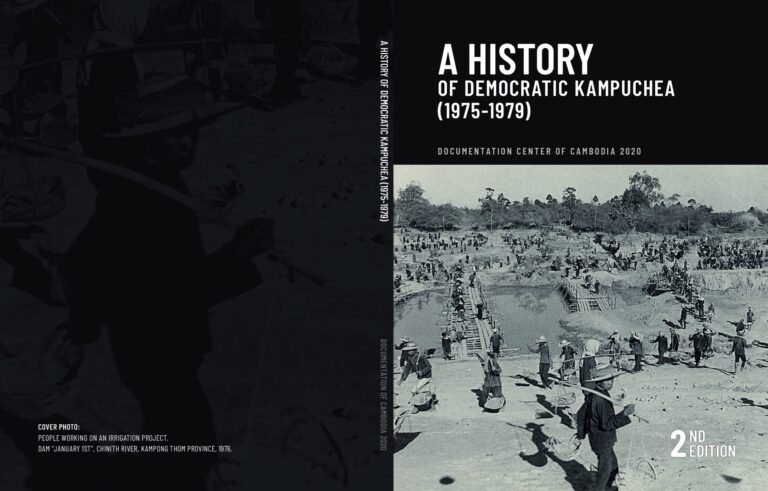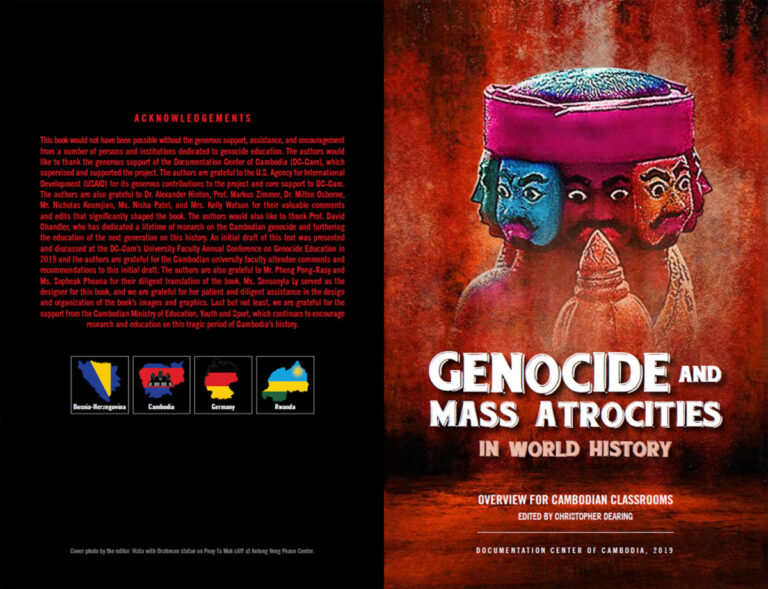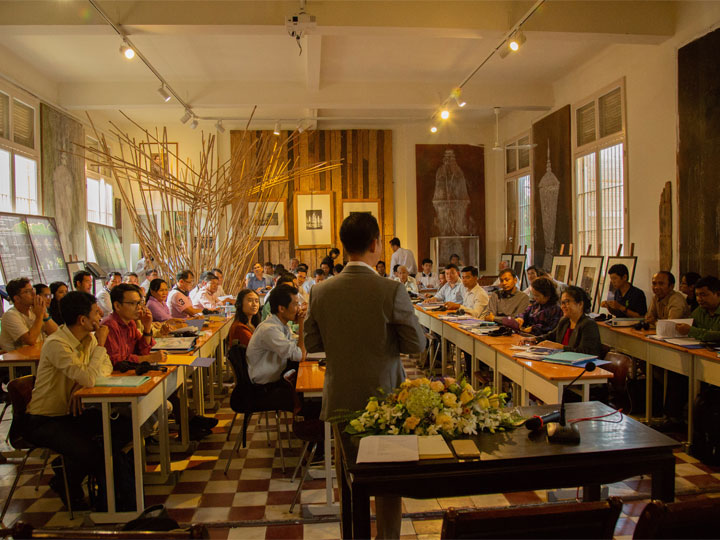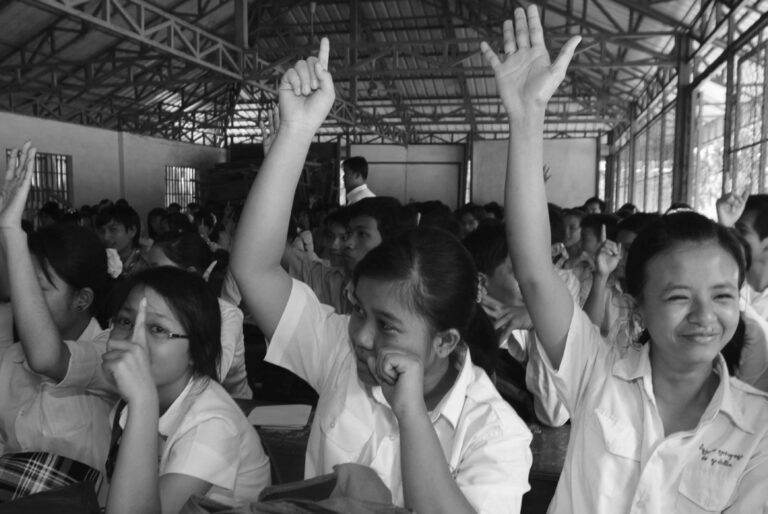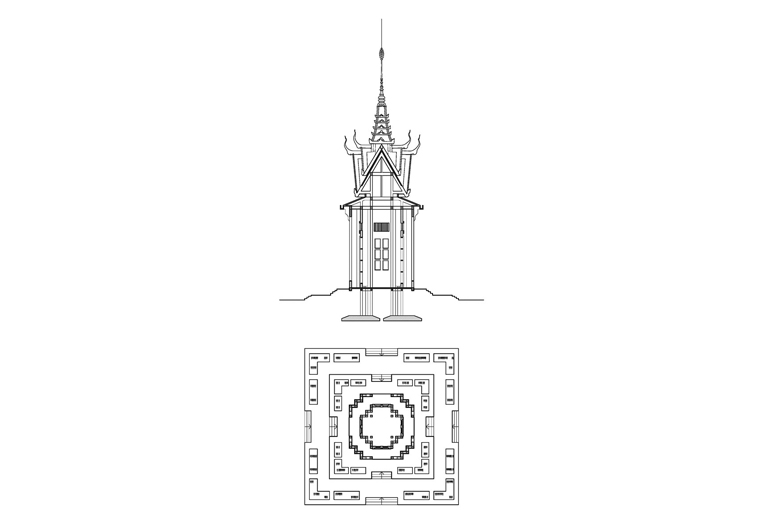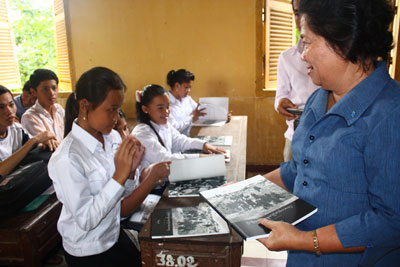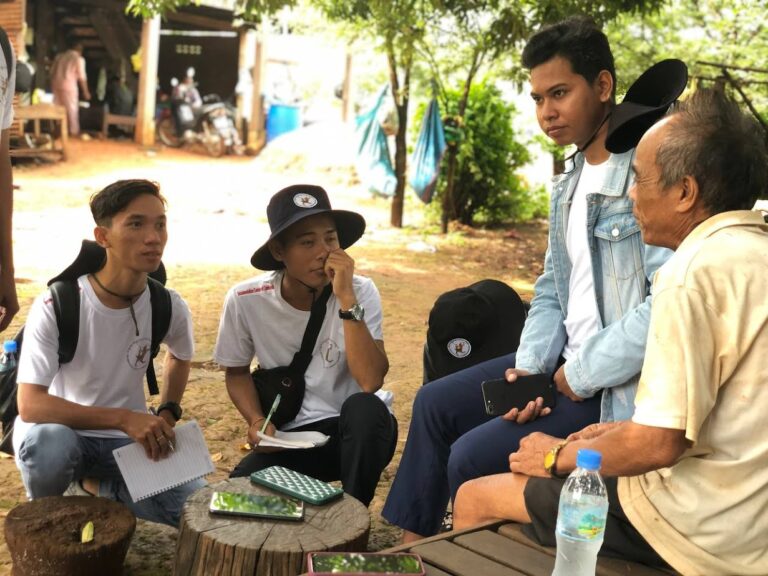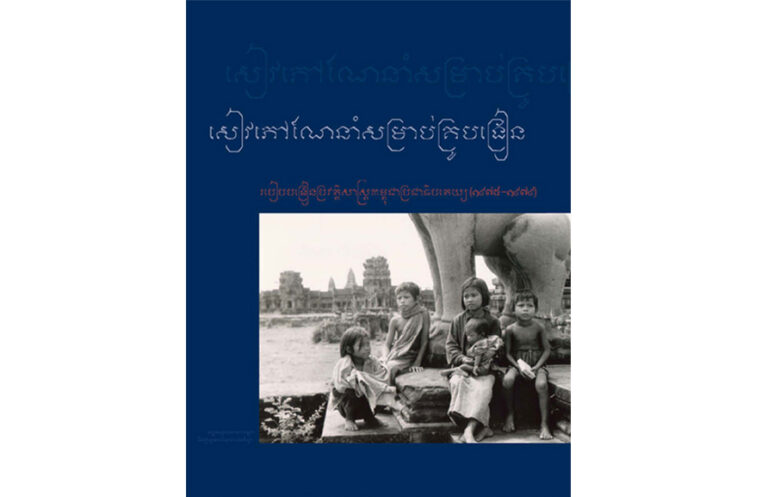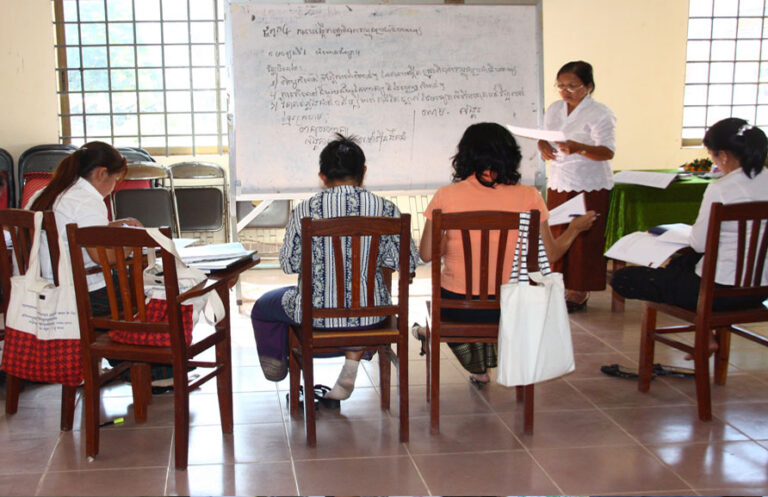The public education forum and textbook distribution began operating in August 2010. The objectives of the forum are to provide education on the Khmer Rouge (KR) history to various Cambodian communities, specifically focusing on people who live in remote areas and have little access to textbooks and publications related to the KR history. The villagers, who are both victims and perpetrators, have the opportunity to create a dialogue and collaborate with teachers in educating their children about what happened during the KR period, as well as to convey the importance of genocide education. The forum encourages the villagers to speak out and share experiences with their children. Teachers are encouraged to use the experiences of the villagers as a resource to educate youth about the history of the KR. In addition, the discussion and personal accounts are supplemented with the textbook, A History of Democratic Kampuchea (1975-1979). The textbook gives a comprehensive explanation of what occurred during the KR regime, and it provides a valuable stimulus for not only greater dialogue, but greater interest in learning more about the history of the DK period. The forum is intended to complement DC-Cam’s support for formal education about KR history in Cambodian classrooms nationwide. The forum also aims to link textbook material to the particular stories of each community—allowing teachers and students to make the best use of their own resources and encourage the villagers to participate with teachers in educating the younger generations about Democratic Kampuchea of Pol Pot.
The forum does not aim to train the villagers to be teachers for their children in a pedagogical sense, rather the goal is to increase community awareness on the larger historical context as well generate a discussion on personal experiences. The forum discussions will be led by three local history teachers who have participated in teacher training sessions on DK history, with the assistance of DC-Cam staff. The forums will provide these teachers with the opportunity to practice the skills, knowledge, and methodology they obtained from the training and increase their overall teaching confidence.
SUMMARY
Since October 2019, Prey Veng Documentation Center has officially opened for public, and hundreds of students, pre-service teachers, teachers and villagers have used this Center to improve their learning of a history of Democratic Kampuchea. As for daily operation of the Center, many high school students and pre-service teachers enter the Center during their break times for learning, researching, and looking for more resources. After two-month operation, a first visit of 33 ECCC’s Civil Parties, KR survivors, and pre-service teachers was taken place at the Center. The visit began at 7:30 and ended at around 11 in the morning. Inside the Center, all visitors sat down and listened to a presentation of a history of Democratic Kampuchea, an establishment of ECCC and its procedures, and a description of Prey Veng Documentation Center’s works. The visitors had opportunity to visit and discuss all permanent photo exhibitions inside and outside the Center. A DC-Cam’s documentary film, Jungle Guard, was screened for them after the visit.
OVERVIEW OF THE PROJECT
Objective
A visit of people who were experienced KR regime and younger generation to Prey Veng Documentation Center aims to (1) preserve and study the memory of survivors; (2) provoke reconciliation and intergenerational discussion of Khmer Rouge history; and (3) increase public understanding of genocide and individual experiences of survivors.
Activities
At around 9 a.m. on December 19, 2019, a tour of 18 civil parties and KR survivors from Toek Thla Commune of Svay Antor District arrived at Prey Veng Documentation Center for their first-time visit to the Center. The tour led by Toek Thla Commune chief and ECCC’s Civil Party Mr. Chhov Dum, aged 78 years old. Inside the Center, a group of 15 pre-service teachers specializing History subject stood up, welcomed, and invited the guests to preserved seats which were arranged for them. With smiling faces, they entered the Center and enjoyed the comfortable room, air-conditionings, beautiful black-and-white photo exhibited, classic furniture and decoration along with bookshelves and cabinets of KR document. They felt relax and powerful to see everything in the Center.
- DK history and ECCC Presentation
Before the tour arrived, a group of 15 first-year pre-service teachers listened to a presentation of a history of Democratic Kampuchea presented by Pheng Pong-Rasy, director of Prey Veng Documentation Center, which was started at 7:30 a.m. After survivors arrived, Rasy summarized his presentation and encouraged them to speak to younger generation about personal experience during KR. Then another presentation of an establishment and procedures of Extraordinary Chamber in the Court of Cambodia (ECCC) began to all participants. Next, Rasy introduced all to listen to an establishment of Prey Veng Documentation Center and its works. It took a bit more time to present each work including outreach activities, KR archives, photo exhibitions, research center, and public use of the Center for multiple purposes. After presentations, participants had opportunity to ask questions before going to next agenda.
- Tour to see photo exhibitions
All participants were toured to see all inside and outside photo exhibitions. Team members – Sanas, Sela and Raksmey – led this session. First of all, the participants were introduced to photos of the 13-portraited S-21 prisoners hanging on the top-wall of the Center. We requested them to read each prisoner’s name appeared on the photo; so that they could recognize which photo is their missing family members. At that time, Rasy spoke to the group of participants that the Center will be responsible for searching for document relating to the photo if any photo is recognized or known. Unfortunately, not anyone of the participants could recognize the photos. Second, participants were moved to see Stung Chinit Dam Photo Exhibited on another wall of the Center. The photos show hard-working people during KR regime to build a big dam at Stung Chinit of Kampong Thom province. After a few minutes, we pointed to another 7-midium photo exhibitions on the left hand-side of Stung Chinit Dam photo. Rasy explained that the photos are about top eastern zone’s KR cadre, So Phim, and his comrades/soldiers and Comrade Hun Sen standing and meeting with his people at Cambodia-Vietnam border in 1977. Third, we moved participants to outside the Center and walked them to see very close to the panels of permanent photo exhibitions.
- Film Screening
A DCCam’s documentary film, Jungle Guard, was screened for participants after the tour. Pre-service teachers and villagers have not seen this film before. In June 2019, DC-Cam’s film team had announced that they would bring the film to screen at Prey Veng Documentation Center, and at least 150 audiences who are students, pre-service teachers and villagers, would be invited to attend this event. Because the screening schedule has canceled, most of audiences requested us to screen this on December 19.
“Jungle Guard is a documentary film that portrays the life of a unique Buddhist monk community that has voluntarily assumed the role of protector of a large parcel of natural forest and its indigenous wildlife, fish and related resources. The forest, known as the Monk Commune Forest, is located in Anlong Veng district, the last stronghold of the Khmer Rouge rebel army and its surviving leaders, in Cambodia’s Oddar Meanchey province.”, said Makara Ouch, a film director. Venerable Bun Saluth, founder of the Monk Commune Forest and film protagonist, founded the forest with a former Khmer Rouge soldier and friend after the monk expressed his dream to protect the environment. This forest was a battlefield between the Khmer Rouge and the Cambodian Government until a peace agreement for Anlong Veng was reached in late 1998. The friend urged the monk to act on his dream to protect and conserve the forest. Attracted to the forest and its rich animal and other resources that were under threat, Venerable Bun Saluth committed his life’s work to protect and preserve it.
- Fill out questions
In order to capture their reflections and personal thought of this program, the team raised 5 questions and put them on a piece of paper and let them to fill out of these questions. The questions are: (1) how do you understand the program this morning? (2) What do you think about the establishment of Prey Veng Documentation Center? (3) What do you learn from the sessions this morning? (4) Will you use Prey Veng Documentation Center for your work and society? The team allowed them 15 minutes to fill out the question form.
ACHIEVEMENT
After finishing the event, all participants expressed personal experiences and feedbacks to the event through a sheet containing 5 questions. Below are their expressions and feedbacks:
Expressions to the Hosted Activity:
- Civil Parties and KR Survivors:
According to question #1, how do you understand the program this morning?, all Civil Parties and KR survivors responded that the program is a necessary tool to increase knowledge of DK history and ECCC’s procedures. Many survivors said that they understand more about procedure of ECCC; for example, Case 001 to Case 004. Moreover, they added that they have learned a lot from experience of other survivors from other parts of Cambodia through document and photo hanged and stored at the Center. In addition, most of survivors believed that the event helps people to remember the past and prevent genocide in the future. Below are summary of answers to the question:
- Understand more about KR history contents;
- Understand more about procedure of ECCC;
- Good event in which all younger generation could learn more about the history from this event.
From the concluded answers above, the event can be a guideline for (1) all Civil Parties and KR survivors to share their personal experiences to younger generation in order to let all the younger generation to memorize the past and create a space for them to express felling of empathy to the older. On the other hand, the event leads to prevent genocide in the future.
- Pre-service Teachers:
Majority of pre-service teachers said that they increased more knowledge on DK history and ECCC’s procedures. Many of them added that they love the program because this program provided them opportunity to meet and discuss the experience during KR regime with Civil Parties and KR survivors. Few pre-service teachers mentioned that the study of a history of DK is important for them and for all people who were born after the Khmer Rouge regime; and another few pre-service teachers said, “This program is good, and I want this program to be happened at schools.”
Expressions to the creation of Prey Veng Documentation Center:
- Civil Parties and KR Survivors:
The respondents believed that the creation of the Center is important for not only the current education, but also long future education for next generation of people. They expressed positive answers to the question with feeling of that the Center build process of healing and reconciliation. “I am happy to see this Center is created, and I supported this,” one respondent said. Not only him, but also other said that they support the Center to work on collecting, storing and preserving evident and documents of the KR history. Another respondent said, “The creation of the Center is very valuable for younger generation to learn about.” Some other said that the Center will be a place where people can share and keep experiences during the KR regime for memory.
- Pre-service Teachers:
Adding to what survivors have mentioned, majority of pre-service teachers mentioned clearly that the Center’s works is to (1) provide broadly information about Khmer Rouge history to public; (2) store and keep all stories of survivors and other document, (3) provide a research center for researcher, (4) teach younger generation about KR history and (5) encourage survivors to share their stories for memory.
Knowledge gained from the program:
- Civil Parties and KR Survivors:
- Understand the ECCC’s procedures;
- Understand the kind of crimes committed during KR regime;
- Understand the ways of protecting forest by Buddhist monk Bun Saluot;
- Understand the tortures during KR regime;
- Pre-service Teachers:
- Increase more knowledge on KR history;
- Increase more knowledge on ECCC;
- Understand the way to protect the forest;
- Understand the establishment of Prey Veng Documentation Center;
- Understand that the Center can help people to find missing member during KR regime.
- Understand the leadership of KR.
The use of Prey Veng Documentation Center in the future:
Both kinds of respondents responded “Yes” to the question: Will you use Prey Veng Documentation Center for your work and society in the future? No one said negative to this questions. However, all the answers did not mention any reason of using this Center in the future.
Recommendation to improve the Program:
- Civil Parties and KR Survivors:
Survivors requested us to (1) explain the DK history to most of the students who were born after the KR; (2) continue to do the same program to different locations and conduct more activities regarding genocide education very often at the communities; (3) encourage all survivors not to forget experience during KR and tell the experience to younger generation; and (4) continue working on preserving memory and collecting more KR document.
- Pre-service Teachers:
According to all answers, majority said they want to have study tour to see some genocide sites. They think that the study tour will help them to learn a lot about the history. In addition to this answer, they want Prey Veng Documentation Center to conduct more educational forums and workshop inside their schools and at communities in the province. Moreover, they needs more Khmer document about KR history so that they want to read these document.
NEXT ACTIVITY
Prey Veng Documentation Center is planning to receive a Center visit of group of 25 high-school students from a high school located in Kanh-chom Commune, Peareang District. This activity will be in January 2020. Through a request from school principal during a Public Forum at Wat Kanh-chom in December 2019, Prey Veng Documentation Center will discuss this more detail with the school principal in order to get specific arrangement to bring the students to visit the Center.
CHALLENGE
- The activity’s agenda was not in order. The agenda of the activity should be ready for the event.
- Some villagers felt exhausted and tied after arriving at the Center.
- Few participating villagers were born after the Khmer Rouge, even if we had told to the commune chief to select people who experienced KR.
RECOMMENDATION
- While asking for reading more Khmer document about KR, all pre-service teachers should be encourage to come to the Office of Prey Veng Documentation and introduce them to all documents stored at 12 cabinets (hardcopy) and at Data Center (softcopy).
- In order to maintain security safe and to reduce payment on transportation, Prey Veng Documentation Center should have a van to transport people and students from where they are living to the Center, and then transport them back to the village.
SUMMARY
40 years after the Khmer Rouge’s collapse, a small number of survivors from Toek Thla commune received their first time of healing and felt that they acted in an important role to build an intergenerational dialogue with their youth on “experiences during the genocide regime in Cambodia.”
51 survivors attended the Public Education Forum to take responsible for telling their experiences during Khmer Rouge regime to 22 students who are also their grandchildren, living everyday with family and villages in Toek Thla commune. Smiling happily and talking to the children, they performed as community teachers. In group discussions, survivors told stories very clearly and gave some good instructions that can be recognized as educational instructions to the children; and children took notes of the stories told, asked questions, and presented the stories to the whole group.
After the forum, a few statements from survivors, who were representatives of all survivors of the forum, were expressed. Survivors felt that they were very close to the children and had the opportunity to tell their experiences. They alsobuilt a connection that contributed to the community’s peace-building, healing and feeling of sympathy to the dark experiences of survivors.
Some of DC-Cam’s publications were distributed to all participants, and these publications became educational resources for students to learn more about Khmer Rouge history. Many survivors asked for more documents. They loved reading and felt satisfied by the forum. They requested more forums in other communes because they believed that this forum will help people to express and share experiences, to build reconciliation and healing of survivors, and may prevent genocide in the future.
INTRODUCTION
In general, in a “public forum”, or public problem-identification and problem-solving session, people discuss important issues. In this well-publicized meeting, the facilitators lead a discussion of various aspects of the community’s strengths and potential problems.
The Khmer Rouge survivors’ potential problem is “untold stories/experiences” or “forgetting the bad experiences of the past”. Younger generations who were born after 1979 are now full of potential to take all they have been seeing and touching, such as exploring social media through their hand phones, computers and other high-tech devices. At the same time, they also have opportunities to learn from what happened in the history of their own country.
One survivor has one story. Sometimes stories are not told because no one asks for the story. Survivors, mostly, feel ashamed to tell their experiences during the Khmer Rouge regime to their young children. Recently, younger and older generations in some parts Cambodia still do not talk to each other about the past, especially bad experiences during the Khmer Rouge regime, even though a majority of the Cambodian population has been connected to build memory of the Khmer Rouge history.
This report is to raise awareness of survivors’ stories by creating a space for them to talk to younger generations in order to share and teach the young not to follow the example of the top Khmer Rouge leaders. In addition, the young will have plenty of opportunity to spend time together, talk with their parents or survivors, and create a specific and important conversation of the experiences of survivors and learning about their experiences.
On November 20, 2019, Prey Veng Documentation Center conducted a public education forum (mobile education forum) to discuss the experiences of survivors of the Khmer Rouge regime, to encourage intergenerational dialogue and to build memory of what happened during the Khmer Rouge time. There were 73 participants, including 51 KR survivors (22 females) and 22 high-school students (10 females), who attended the forum. The forum began at 10 in the morning and ended around noon. All 51 villagers or KR survivors were selected from five different villages of Toek Thla Commune by Commune Chief, Mr. Chhauv Dum; and all 22 students were allowed by their school principal to join the discussion during the forum’s session.
GEOGRAPHICAL BACKGROUND

Toek Thla Commune is one of the eleven communes in Svay Antor district. According to the 2008 National Census, there were 8,002 residents living in Toek Thla (National Census wrote: Tuek Thla). Mr. Chhauv Dum said that villagers in his commune are living peacefully, giving to each other and financially well. Unlike living under the Khmer Rouge regime, people lived in cooperatives and had no rights. People were forced to work and were sometimes killed without reasons.
HISTORICAL BACKGROUND
At least two specific events happened during the Khmer Rouge time in Svay Antor District. One was ethnic cleansing of mixed Cambodian-Vietnamese which was took place in Svay Antor Commune. In 2016, the Extraordinary Chamber in the Courts of Cambodia (ECCC) listened to more testimony in relation to the Khmer Rouge policy in which the children of mixed Cambodian-Vietnamese parents were to be murdered if their mothers or fathers were Vietnamese.
Another event was a rebellion of former So Phim’s right-hand Khmer Rouge cadres to the Khmer Rouge cadres coming from Southwestern Zone. The rebellion happened in Toek Thla Commune where the team worked during the trip in August 2019. Both events were in 1978. Most of villagers who were living in Toek Thla commune were evacuated to Kampong Chhnang, Pursat and Battambang provinces. This happened after a group of people rebelled against another group who were recognized as KR cadres from the Southwestern Zone. The rebellion took place at Wat Prey Lveay, located in Prich Village. During the one-day rebellion, many villagers died or were injured. A former commune chief who belonged to Khmer Rouge cadres from the Eastern Zone and a head of the rebellion died of hanging by the neck from bamboo tree after knowing that his group could not win the fighting.
OBJECTIVES
- Provide education on the Khmer Rouge history to isolated Cambodian communities, where there is little access to textbooks and publications related to this history.
- Encourage villagers to speak out and share their experiences from the Khmer Rouge regime, finding healing and reconciliation.
- Provide an opportunity to both victims and perpetrators to create a dialogue and collaborate with teachers in educating their children about what happened during the Khmer Rouge period.
- Demonstrate the importance of genocide education.
- Bring awareness to the community about the larger historical context of their own personal experiences. The forum encourages teachers to use the experiences of the villagers as a resource to educate youth about the history of the Khmer Rouge.
ACTIVITIES
Pre-Forum
On November 18, the Prey Veng Documentation Center team, Rasy, Sanas and Sela, went to Toek Thla Commune to meet with Mr. Chhauv Dum. He was home when we reached the commune office. Then we went to his home and discussed some works such as asking permission to conduct the forum at his commune, requesting the participation of villagers who experienced the KR regime and students who are studying and living in the commune, searching for a location to conduct the forum, and presenting the forum’s activities.
The Commune Chief responded to the team as follows:
- Approved the Mobile or Public Education Forum at his commune;
- Agreed to invite at least 30 villagers in all five villages of the commune to attend the forum;
- Agreed to spread out this information to the school nearby and invited students to attend the forum.
- Allowed us to conduct the forum at Wat Toek Thla.
- Agreed to give his remark to the forum before the forum begins its session.
The Forum
The forum started around 10 a.m. with 73 participants.
The agenda:
- Introduction by Pheng Pong-Rasy, Director of Prey Veng Documentation Center;
- Opening remarks by Chauov Dum, Commune Chief;
- Remarks by the USAID officials – Jean-Marc, Deputy Director of Democracy and Governance, and Kruce Kay, Director of Democracy and Governance;
- Presentation a DK history by Pheng Pong-Rasy;
- Intergenerational Group Discussions by villagers and students observed by Chhauv Dum, Sanas, Sela and Rasy;
- Presentation of survivors stories by students;
- Feedback to the presentation by survivors;
- Distribution of textbook and other documents; and
- Distribution of survey to measure the participant’s knowledge after the forum.
- Introduction to the Forum
Rasy introduced the team to the participants and told the purpose of the today’s forum. Rasy mentioned clearly that survivors are distributors who share personal stories with the students who are receive the story and learn from the story. Next, Rasy invited Mr. Chhauv Dum to give his remarks to the participants.
- Open Remarks by the Commune Chief
Mr. Chhauv Dum started with thanks to all participants who attended the forum. He also thanked the school principal who allowed his students to join the event. Mr. Chhauv Dom guided all participants to listen to the presentation, follow the group discussion, and share personal experiences as well as any event happening in the commune during the KR regime. He thanked DC-Cam’s Prey Veng Documentation Center to create this event. He believed that this event would build good conversation between younger and older generations on KR history.
- Remarks by the USAID officials – Jean-Marc Gorelick and Bruce Kay from the Office of Democracy and Governance
Jean-Marc Gorelick:
“… we support the work of building peace, national reconciliation through education. If we all remember the past experience, we believed this history is not repeated. As you know DC-Cam is the world’s largest Khmer Rouge archives. I am very proud about the work of DC-Cam. I am so happy to see all of you today and it is so much help and I thank to all of you. I cannot wait to learn from all of you. I am a student today. Thank you again so much and so happy to be here!”
Bruce Kay:
“Good morning! I am Bruce Kay. I am working for USAID. I just want to say how happy I am to be here today. And I just want to say thank you everybody today in the villages and thank you for the village chief for extending very kind welcoming and invitation to us to be here; and I would like to thank all of you from DC-Cam for the great work that DC-Cam does here in Prey Veng Province. I would love to spend a few hours with you and learn from you. Thank you so much!”
- Presentation
- Democratic Kampuchea History
Pheng Pong-Rasy was a presenter. Slide presentations were designed using more pictures than text. Eight Khmer Rouge’s political points of views below were explained to the participants.
- Evacuation of people from Phnom Penh and provincial towns;
- Abolition of money and free markets;
- Abolition of normal schools and educational institutes, pagoda and religious practices and cultures, and private property;
- Deprivation of human basic rights;
- Criticizing and forbidding family relationship;
- Creation of cooperatives;
- Execution and torturing enemies
- Clashes broke out between Cambodia and Vietnam.
- Prey Veng Documentation Center
Pheng Pong-Rasy introduced and gave all participants a tour of DC-Cam’s brand new office called Prey Veng Documentation Center.The center serves as a library of Khmer Rouge-related documents, a research center, and amuseum of Khmer Rouge photos.
Rasy added that Prey Veng Documentation Center is happy to welcome all visitors, especially survivors who are now living in Toek Thla commune. In a talk on November 18, Mr. Chhauv Dum mentioned that he will propose a trip to visit the center sometime in the near future. Rasy responded positively by saying that center staff await this trip and will work on an agenda for this meeting. As an official conversation after the forum, more survivors were very interested in visiting the center. However, Prey Veng Documentation Center would pay for transportation and refreshment fees.
- Intergenerational Group Discussions
After finishing the DK history presentation, the participants were divided into five different groups for discussion. Each group consisted of survivors and students, and they acted in different roles. Rasy gave five different topics to the groups to discuss:
Group One: Life under Khmer Rouge between 1975-1977.
Group Two: Life of Eastern Zone people in 1978.
Group Three: Evacuation of Eastern Zone in late 1978 to west of country.
Group Four: Rebellion in 1978 at Prey Lveay pagoda located in Toek Thla commune.
Group Five: Overwork of people during Khmer Rouge regime at Toek Thla commune.
The group discussions had half-an-hour for discussion. Survivors engaged very well with the students. Some survivors instructed the students to take note of all the stories told, and very often they repeated the stories so that the students could follow and understand clearly. Every group discussion, survivors felt happy and loved to share their experiences during the Khmer Rouge with the students, and the students asked for more detailed information about the experiences. At the end of group discussion, students produced at least a page of hand-written stories from survivors.
- Presentation of survivors stories by students
Students at this time played an important role in the presentation of the stories to the whole forum. Each group had 5 to 7 minutes to present what they had learned from the groups. Most of the students carried a piece of paper and read loudly to participants. The elders sat quietly on the chairs of every group and listened to their stories.
- Feedback to the presentation by survivors
Each student group presentation ended with comments and feedback from survivors. For example, the students were instructed to improve their writing and listening skills in a forum like this. Some student groups were given good lessons by the survivors such as: 1) how to summarize the story; 2) thinking about and noting important phrases; and 3) improving reading skills by reading more books and other resources.
- Distribution of textbooks and other documents
A few publications were distributed to all 73 participants. More survivors asked for more books and resources. They wanted to keep all the resources at home so that their children and families could have a chance to read them.
- Distribution of survey to measure the participant’s knowledge after the forum
Less than 70 survey forms were distributed to the participants to fill in. The commune chief said that most participating survivors can read and write, so they could fill out the form for us. However, a commune clerk and deputy chief helped some survivors to complete the form.
RESULT AND DISCUSSION
(Data analysis using SPSS software and the discussion of the data will be here)
IMPACT
Survivors
Four randomly selected survivors from the forum said during the interview after the forum that they were very satisfied with the event. They would love to have such an event again somewhere in the district, focusing on everyday life in the community under the Khmer Rouge regime; and the children would learn from this dialogue and build sympathy and hopefully find ways to stop any event that could lead to genocide in the future.
One female survivor came to the front of the forum and said that she felt very good.Long-felt emotional pain seemed to be released after she shared her experiencewith the students and other survivors. She continued that the forum was very meaningful for her life, and it is very important for every survivor who wants to heal and reconcile their stress 40 years after the Khmer Rouge’s collapse to talk and share the bad experience with family members, children and community.
One male survivor who is now a village chief spoke to the group of students, saying that he has never forgotten what happened to his family and always wanted to share this experience with the children.
Students/children
This was the first time they joined an event like this. Everyone felt more confident learning from survivors and loved listening to the stories. More questions were asked to survivors. The students learned a lot from the survivors. A few students said that they will distribute this knowledge to their peers in school and continue to read and search for more information about Khmer Rouge history.
The Donor
A day after the forum, November 21, Bruce Kay emailed DC-Cam’s director, Youk Chhang, to thank him for allowing USAID to visit Prey Veng Documentation Center and the forum. Below is Bruce Kay’s email:
“Hi Youk – just a note to say I was really impressed by the outdoor history forum and intergenerational dialogue in Prey Veng yesterday. I’ve never seen anything quite like it. I was quite moved to watch the older folks speak with such warmth and honesty to the school children present about the hardships they experienced during Khmer Rouge period. It made me think of my own Polish/Jewish grandparents and the difficulty they had verbalizing their own experiences. I thought Rassi (Rasy) did a great job teaching as well and appreciate his letting us tour the Peace Center and review a few interesting documents. Thanks to DC-Can for giving Jean-Marc Terith and I the opportunity. It makes me proud to be supporting this initiative.”
CHALLENGE/LESSON LEARNED
Because the forum took place in a very rural area, we were unable to invite high school students to join the event. The high school is located far away from the location where we conducted the forum. The students who joined were grade-nine students, below the age of 18.
We also learned that the students found it hard to take notes about the stories told by the survivors. They need to improve their reading, writing and listening skills and learn to capture the most important statements from the story. They also need to know how to summarize the stories.
RECOMMENDATION
The next forum should begin around 8 or 8:30 in the morning and finish at 10:30. Villagers usually have lunch around 10:30 or 11.
The presentation of chapters of DK history should not be longer than 40 minutes, and topics discussed during intergenerational group discussion should focus on only ONE topic. Doing this, we will be able to control the groups and capture more information from the topic from each group.
CONCLUSION
The forum went well and the depth of sharing was higher than expected. Survivors felt that they were held a very important role, teaching and telling their stories to students. This informal education does not only build more knowledge of Khmer Rouge history for youth, but also creates a process of healing and establishes peace-building, reconciliation and genocide prevention for the future.
End.
Team: Pheng Pong-Rasy, Min Sanas, Phat Sela
Report: Pheng Pong-Rasy
English Edited: Nicole Feldman
Photos: https://photos.app.goo.gl/5Tm3ix8oNqd7yLYZ9
- Pre-Forum Survey for Teachers: English | Khmer
- Pre-Forum Survey for Students: English | Khmer
- Pre-Forum Survey for Parents: English | Khmer
- Post-Forum Survey for Teachers: English | Khmer
- Post-Forum Survey for Students: English | Khmer
- Post-Forum Survey for Parents: English | Khmer
- Evaluation Form: English | Khmer
Weekend Community Education Forum: The History of Democratic Kampuchea (1975-1979), October 08, 2023
Weekend Community Education Forum: Recalling the Survivors’ Experience on the KR Dam, July 14, 2023
Genocide Education, Genocide Prevention: Community Education Forum, June 17, 2023
Weekend Community Education Forum: The DK History (1975-1979), June 11, 2023
Genocide Education In Cambodia: A Day of Work in the Sewing Unit, March 2023
Community Education Forum: Education of the Children During the Khmer Rouge Regime, March 12, 2023
DC-Cam Community Education Forum. Takeo Documentation Center, February 18, 2023|Phnom Penh Post
Community Education Forum in Koh Sotin District: A Day of Work in the Mobile Unit, February 12, 2023
Weekend Intergenerational Forum: Meeting with Khmer Rouge Survivors, July 17, 2022
Weekend Intergenerational Forum on the History of Democratic Kampuchea (1975-1979), March 22, 2022
Takeo Province on September 20, 2012: Photo | Report
First Report on Public Education Forum for The Asia Foundation: March 2011
Second Report on Public Education Forum for The Asia Foundation: June 2011
Third Narrative Report on Public Education Forum for the Asia Foundation: June 01-August 30, 2011
Final Narrative Report on Public Education Forum for TAF
Mondul Kiri Province on October 25, 2011: Photo | Report
Siem Reap Province on October 9, 2011: Photo | Report
Svay Rieng Province on October 6, 2011: Photo | Report
Prey Veng Province on October 4, 2011: Photo | Report
Battambang Province on September 23, 2011: Photo | Report
Kampong Chhnang Province on September 21, 2011: Photo | Report
Kampong Speu Province on September 19, 2011: Photo | Report
Preah Vihear on September 6, 2011: Photo | Report
Pursat on August 11, 2011: Photo | Report
Kep on August 7, 2011: Photo | Report
Preah Sihanouk on July 23, 2011: Photo | Report
Pailin on July 10, 2011: Photo | Report
Uddar Meanchey on June 18, 2011: Photo | Report
Phnom Penh on June 5, 2011: Photo | Report
Kampot on May 22, 2011: Photo | Report
Kandal on May 8, 2011: Photo | Report
Mondulkiri on April 26, 2011: Photo | Report
Stung Treng on April 24, 2011: Photo | Report
Ratanak Kiri on March 20, 2011: Photo | Report
Kampong Cham on March 6, 2011: Photo | Report
Kampong Thom on February 20, 2011: Photo | Report
Banteay Meanchey on February 6, 2011: Photo | Report
Koh Kong on January 9, 2011: Photo | Report
Kratie on November14, 2010: Photo | Report
Takeo on October 17, 2010: Photo | Report
Kampong Chhnang on September 25, 2010: Photo | Report
Prey Veng on August 29, 2010: Photo | Report
Kampong Speu on August 23, 2010: Photo | Report
